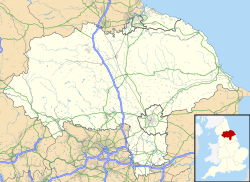History
The earliest reference to the castle records a visit from King John in 1201. [2]
The remaining parts of Ravensworth Castle date from the late 14th century, when it belonged to Henry, 1st Baron FitzHugh. [3] [4] In 1391 he enclosed 200 acres (81 ha) around the castle, creating a park. [5] The castle was gradually dismantled, starting in the 16th century, and the stone was used for other buildings in the area. [5]
Ravensworth Castle and Park Wall were given a Grade I listed building designation by English Heritage on 4 February 1969. [3] The Grade I listing is for buildings "of exceptional interest, sometimes considered to be internationally important". [6] The castle and nearby earthworks have been designated a scheduled monument. [3]
This page is based on this
Wikipedia article Text is available under the
CC BY-SA 4.0 license; additional terms may apply.
Images, videos and audio are available under their respective licenses.

